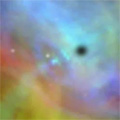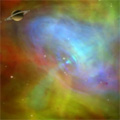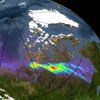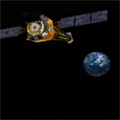CXC Home | Search | Help | Image Use Policy | Latest Images | Privacy | Accessibility | Glossary | Q&A
1. Alternative Without Optical Titan, Only the Shadow (unlabeled)
QuicktimeMPEG On January 5, 2003, Titan crossed in front of the Crab Nebula, blocking some of X-rays emitted by the Crab. This animation illustrates how Titan, one of Saturn's moons, casts an X-ray "shadow" on Chandra's detector as it passes between the Crab Nebula and Chandra. Although Titan passes within a few degrees of the Crab Nebula every 30 years, it rarely passes directly in front of it. This may have been the first transit of the Crab Nebula by Titan since the nebula was formed by a supernova that was observed to occur in the year 1054. The next similar conjunction will take place in the year 2267, so this was truly a once in a millennium event. The Crab Nebula image in the animation shows X-ray data in blue, optical in green, and radio in red.
[Runtime: 0:33]
(NASA/CXC/A.Hobart; Crab Nebula: X-ray: NASA/CXC/ASU/J.Hester et al.; Optical: NASA/HST/ASU/J.Hester et al.; Radio: NRAO/AUI/NSF; Titan's Shadow: NASA/CXC/Penn State/K.Mori et al.)
Related Chandra Images:
QuicktimeMPEG On January 5, 2003, Titan crossed in front of the Crab Nebula, blocking some of X-rays emitted by the Crab. This animation illustrates how Titan, one of Saturn's moons, casts an X-ray "shadow" on Chandra's detector as it passes between the Crab Nebula and Chandra. Although Titan passes within a few degrees of the Crab Nebula every 30 years, it rarely passes directly in front of it. This may have been the first transit of the Crab Nebula by Titan since the nebula was formed by a supernova that was observed to occur in the year 1054. The next similar conjunction will take place in the year 2267, so this was truly a once in a millennium event. The Crab Nebula image in the animation shows X-ray data in blue, optical in green, and radio in red.
[Runtime: 0:33]
(NASA/CXC/A.Hobart; Crab Nebula: X-ray: NASA/CXC/ASU/J.Hester et al.; Optical: NASA/HST/ASU/J.Hester et al.; Radio: NRAO/AUI/NSF; Titan's Shadow: NASA/CXC/Penn State/K.Mori et al.)
Related Chandra Images:
- Photo Album: Titan
2. Alternative Without Optical Titan, Only the Shadow (labeled)
QuicktimeMPEG On January 5, 2003, Titan crossed in front of the Crab Nebula, blocking some of X-rays emitted by the Crab. This animation illustrates how Titan, one of Saturn's moons, casts an X-ray "shadow" on Chandra's detector as it passes between the Crab Nebula and Chandra. Although Titan passes within a few degrees of the Crab Nebula every 30 years, it rarely passes directly in front of it. This may have been the first transit of the Crab Nebula by Titan since the nebula was formed by a supernova that was observed to occur in the year 1054. The next similar conjunction will take place in the year 2267, so this was truly a once in a millennium event. The Crab Nebula image in the animation shows X-ray data in blue, optical in green, and radio in red.
[Runtime: 0:33]
(NASA/CXC/A.Hobart; Crab Nebula: X-ray: NASA/CXC/ASU/J.Hester et al.; Optical: NASA/HST/ASU/J.Hester et al.; Radio: NRAO/AUI/NSF; Titan's Shadow: NASA/CXC/Penn State/K.Mori et al.)
Related Chandra Images:
QuicktimeMPEG On January 5, 2003, Titan crossed in front of the Crab Nebula, blocking some of X-rays emitted by the Crab. This animation illustrates how Titan, one of Saturn's moons, casts an X-ray "shadow" on Chandra's detector as it passes between the Crab Nebula and Chandra. Although Titan passes within a few degrees of the Crab Nebula every 30 years, it rarely passes directly in front of it. This may have been the first transit of the Crab Nebula by Titan since the nebula was formed by a supernova that was observed to occur in the year 1054. The next similar conjunction will take place in the year 2267, so this was truly a once in a millennium event. The Crab Nebula image in the animation shows X-ray data in blue, optical in green, and radio in red.
[Runtime: 0:33]
(NASA/CXC/A.Hobart; Crab Nebula: X-ray: NASA/CXC/ASU/J.Hester et al.; Optical: NASA/HST/ASU/J.Hester et al.; Radio: NRAO/AUI/NSF; Titan's Shadow: NASA/CXC/Penn State/K.Mori et al.)
Related Chandra Images:
- Photo Album: Titan
3. Animation of Titan's Transit of the Crab Nebula (unlabeled)
QuicktimeMPEG On January 5, 2003, Titan crossed in front of the Crab Nebula, blocking some of X-rays emitted by the Crab. This animation illustrates how Titan, one of Saturn's moons, cast an X-ray "shadow" on Chandra's detector as Titan passed between the Crab Nebula and Chandra. This part of the animation shows how the event might look from the point of view of an observer watching the Chandra ACIS detector during the transit. This observer would not, of course, see the optical image of Titan, which is shown for reference. Although Titan passes within a few degrees of the Crab Nebula every 30 years, it rarely passes directly in front of it. This may have been the first transit of the Crab Nebula by Titan since the nebula was formed by a supernova that was observed to occur in the year 1054. The next similar conjunction will take place in the year 2267, so this was truly a once in a millennium event. The image of the Crab Nebula in the animation shows X-ray data in blue, optical in green, and radio in red.
[Runtime: 0:33]
(NASA/CXC/A.Hobart; Crab Nebula: X-ray: NASA/CXC/ASU/J.Hester et al.; Optical: NASA/HST/ASU/J.Hester et al.; Radio: NRAO/AUI/NSF; Titan's Shadow: NASA/CXC/Penn State/K.Mori et al.)
Related Chandra Images:
QuicktimeMPEG On January 5, 2003, Titan crossed in front of the Crab Nebula, blocking some of X-rays emitted by the Crab. This animation illustrates how Titan, one of Saturn's moons, cast an X-ray "shadow" on Chandra's detector as Titan passed between the Crab Nebula and Chandra. This part of the animation shows how the event might look from the point of view of an observer watching the Chandra ACIS detector during the transit. This observer would not, of course, see the optical image of Titan, which is shown for reference. Although Titan passes within a few degrees of the Crab Nebula every 30 years, it rarely passes directly in front of it. This may have been the first transit of the Crab Nebula by Titan since the nebula was formed by a supernova that was observed to occur in the year 1054. The next similar conjunction will take place in the year 2267, so this was truly a once in a millennium event. The image of the Crab Nebula in the animation shows X-ray data in blue, optical in green, and radio in red.
[Runtime: 0:33]
(NASA/CXC/A.Hobart; Crab Nebula: X-ray: NASA/CXC/ASU/J.Hester et al.; Optical: NASA/HST/ASU/J.Hester et al.; Radio: NRAO/AUI/NSF; Titan's Shadow: NASA/CXC/Penn State/K.Mori et al.)
Related Chandra Images:
- Photo Album: Titan
4. Animation of Titan's Transit of the Crab Nebula (labeled)
QuicktimeMPEG On January 5, 2003, Titan crossed in front of the Crab Nebula, blocking some of X-rays emitted by the Crab. This animation illustrates how Titan, one of Saturn's moons, cast an X-ray "shadow" on Chandra's detector as Titan passed between the Crab Nebula and Chandra. This part of the animation shows how the event might look from the point of view of an observer watching the Chandra ACIS detector during the transit. This observer would not, of course, see the optical image of Titan, which is shown for reference. Although Titan passes within a few degrees of the Crab Nebula every 30 years, it rarely passes directly in front of it. This may have been the first transit of the Crab Nebula by Titan since the nebula was formed by a supernova that was observed to occur in the year 1054. The next similar conjunction will take place in the year 2267, so this was truly a once in a millennium event. The image of the Crab Nebula in the animation shows X-ray data in blue, optical in green, and radio in red.
[Runtime: 0:33]
(NASA/CXC/A.Hobart; Crab Nebula: X-ray: NASA/CXC/ASU/J.Hester et al.; Optical: NASA/HST/ASU/J.Hester et al.; Radio: NRAO/AUI/NSF; Titan's Shadow: NASA/CXC/Penn State/K.Mori et al.)
Related Chandra Images:
QuicktimeMPEG On January 5, 2003, Titan crossed in front of the Crab Nebula, blocking some of X-rays emitted by the Crab. This animation illustrates how Titan, one of Saturn's moons, cast an X-ray "shadow" on Chandra's detector as Titan passed between the Crab Nebula and Chandra. This part of the animation shows how the event might look from the point of view of an observer watching the Chandra ACIS detector during the transit. This observer would not, of course, see the optical image of Titan, which is shown for reference. Although Titan passes within a few degrees of the Crab Nebula every 30 years, it rarely passes directly in front of it. This may have been the first transit of the Crab Nebula by Titan since the nebula was formed by a supernova that was observed to occur in the year 1054. The next similar conjunction will take place in the year 2267, so this was truly a once in a millennium event. The image of the Crab Nebula in the animation shows X-ray data in blue, optical in green, and radio in red.
[Runtime: 0:33]
(NASA/CXC/A.Hobart; Crab Nebula: X-ray: NASA/CXC/ASU/J.Hester et al.; Optical: NASA/HST/ASU/J.Hester et al.; Radio: NRAO/AUI/NSF; Titan's Shadow: NASA/CXC/Penn State/K.Mori et al.)
Related Chandra Images:
- Photo Album: Titan
5. Sequence of Chandra Earth Aurora Images
QuicktimeMPEG The bright arcs in this sample of Chandra images show low-energy X-rays (0.1 - 10 kilo electron volts) generated during auroral activity. The images are approximately 20-minute scans during which Chandra was pointed at a fixed point in the sky and the Earth's motion carried the auroral regions through the field of view. The estimated altitude of the X-ray emission is 100 km. Auroras are produced by solar storms that disturb Earth's magnetic field and accelerate electrons which speed along the magnetic field into the polar regions. There the electrons collide with atoms high in Earth's atmosphere and emit X-rays.
[Runtime: 0:10]
(X-ray: NASA/MSFC/CXC/A.Bhardwaj & R.Elsner, et al.; Earth model: NASA/GSFC/L.Perkins & G.Shirah)
Related Chandra Images:
QuicktimeMPEG The bright arcs in this sample of Chandra images show low-energy X-rays (0.1 - 10 kilo electron volts) generated during auroral activity. The images are approximately 20-minute scans during which Chandra was pointed at a fixed point in the sky and the Earth's motion carried the auroral regions through the field of view. The estimated altitude of the X-ray emission is 100 km. Auroras are produced by solar storms that disturb Earth's magnetic field and accelerate electrons which speed along the magnetic field into the polar regions. There the electrons collide with atoms high in Earth's atmosphere and emit X-rays.
[Runtime: 0:10]
(X-ray: NASA/MSFC/CXC/A.Bhardwaj & R.Elsner, et al.; Earth model: NASA/GSFC/L.Perkins & G.Shirah)
Related Chandra Images:
- Photo Album: Earth Aurora
6. Virtual Voyage through the Milky Way: Earth to Local Group
QuicktimeMPEG Zoom out past Earth, Venus, Mercury & the Sun. Go beyond the solar system, and out of the Milky Way to our Local Group.
[Runtime: 0:56]
(NASA/CXC/A.Hobart)
QuicktimeMPEG Zoom out past Earth, Venus, Mercury & the Sun. Go beyond the solar system, and out of the Milky Way to our Local Group.
[Runtime: 0:56]
(NASA/CXC/A.Hobart)






